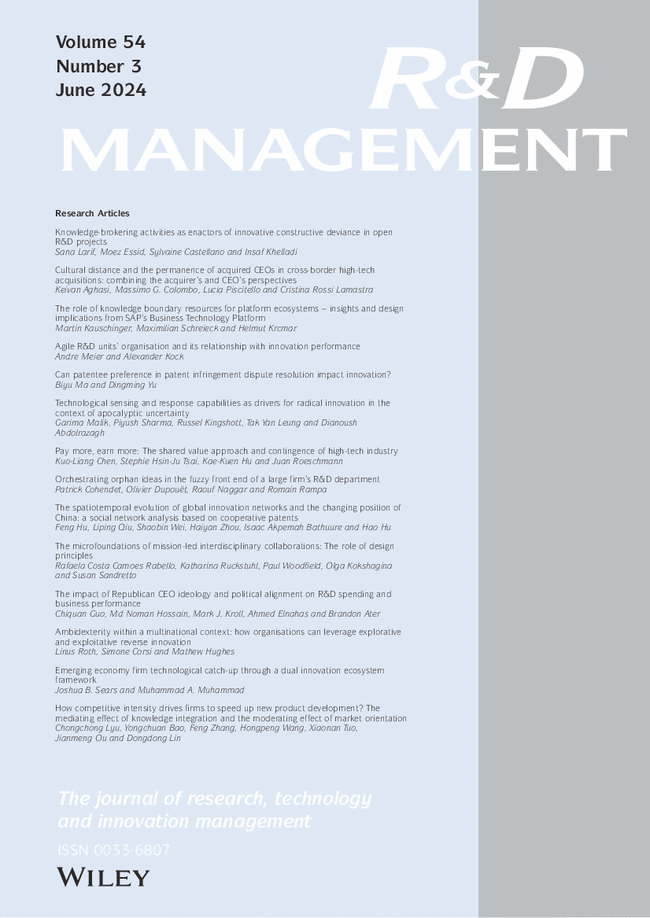Corporate governance and innovation: a predictive modeling approach using machine learning
IF 5.7
2区 管理学
Q1 BUSINESS
引用次数: 0
Abstract
The examination of the associations between internal corporate governance (CG) mechanisms and innovation faces challenges due to nonlinear patterns and complex interactions. Consequently, existing literature rarely reaches a consensus on the directions or strengths of these relationships. Furthermore, to investigate the CG–innovation association, prior research has predominantly relied on explanatory modeling, which involves applying statistical models to data to test correlational or causal hypotheses about theoretical constructs. These are the reasons why it remains unclear whether internal CG mechanisms, when considered collectively as an extensive array of interconnected variables, offer valuable insights for accurately predicting innovation. To address this gap, we analyze a dataset of research and development (R&D) projects from the Brazilian electricity sector by employing predictive modeling, which entails using statistical models or data mining algorithms to predict new observations, particularly using supervised machine learning (ML) methods. Our study demonstrates that a comprehensive set of variables representing internal CG mechanisms significantly enhances the predictive capabilities of ML algorithms for innovation. Furthermore, we illustrate how ML can illuminate nonlinear and non‐monotonic patterns, and interactions among variables, in the CG–innovation relationship. Our contribution to the literature encompasses three key aspects: introducing a predictive modeling approach to the discourse on the role of CG in innovation attainment through R&D endeavors, which can complement and enrich existing explanatory research; investigating non‐linear and non‐monotonic relationships, as well as interactions, in innovation prediction; and affirming the emerging body of literature that recognizes supervised ML as a valuable tool accessible to management researchers.公司治理与创新:利用机器学习的预测建模方法
由于非线性模式和复杂的相互作用,研究内部公司治理(CG)机制与创新之间的关系面临着挑战。因此,现有文献很少就这些关系的方向或强度达成共识。此外,为了研究公司治理与创新的关系,以往的研究主要依赖于解释性建模,即对数据应用统计模型来检验理论构造的相关或因果假设。正是由于这些原因,人们还不清楚,如果将企业文化的内部机制视为一系列相互关联的广泛变量,那么这些机制是否能为准确预测创新提供有价值的见解。为了填补这一空白,我们采用预测建模方法分析了巴西电力行业的研发(R&D)项目数据集,这需要使用统计模型或数据挖掘算法来预测新的观察结果,特别是使用有监督的机器学习(ML)方法。我们的研究表明,一组代表内部 CG 机制的综合变量可显著增强 ML 算法对创新的预测能力。此外,我们还说明了 ML 如何能够揭示 CG 与创新关系中的非线性和非单调模式,以及变量之间的相互作用。我们对文献的贡献主要体现在三个方面:在关于企业文化在通过研发努力实现创新中的作用的讨论中引入了一种预测建模方法,这种方法可以补充和丰富现有的解释性研究;研究创新预测中的非线性和非单调关系以及相互作用;以及肯定新出现的文献,这些文献认为有监督的 ML 是管理研究人员可以使用的一种有价值的工具。
本文章由计算机程序翻译,如有差异,请以英文原文为准。
求助全文
约1分钟内获得全文
求助全文
来源期刊

R&D Management
Multiple-
CiteScore
11.30
自引率
9.50%
发文量
0
期刊介绍:
R&D Management journal publishes articles which address the interests of both practising managers and academic researchers in research and development and innovation management. Covering the full range of topics in research, development, design and innovation, and related strategic and human resource issues - from exploratory science to commercial exploitation - articles also examine social, economic and environmental implications.
 求助内容:
求助内容: 应助结果提醒方式:
应助结果提醒方式:


